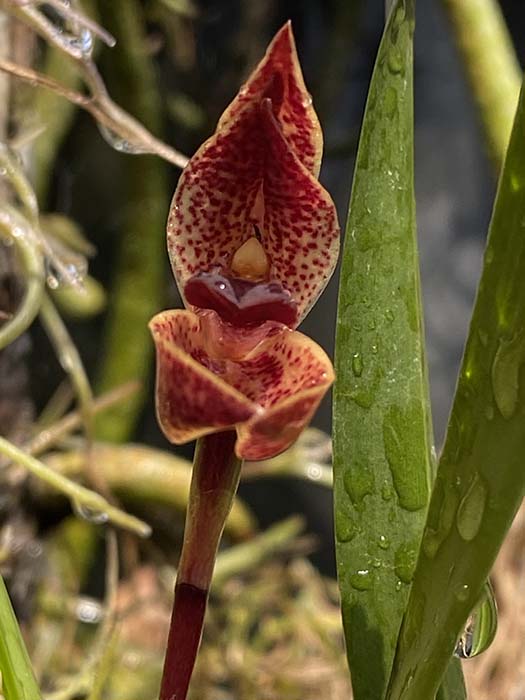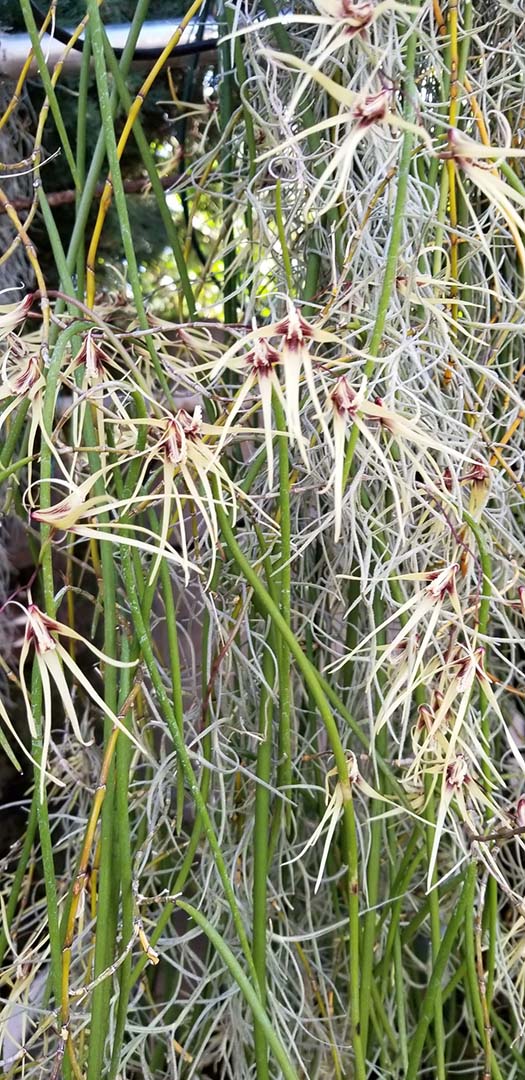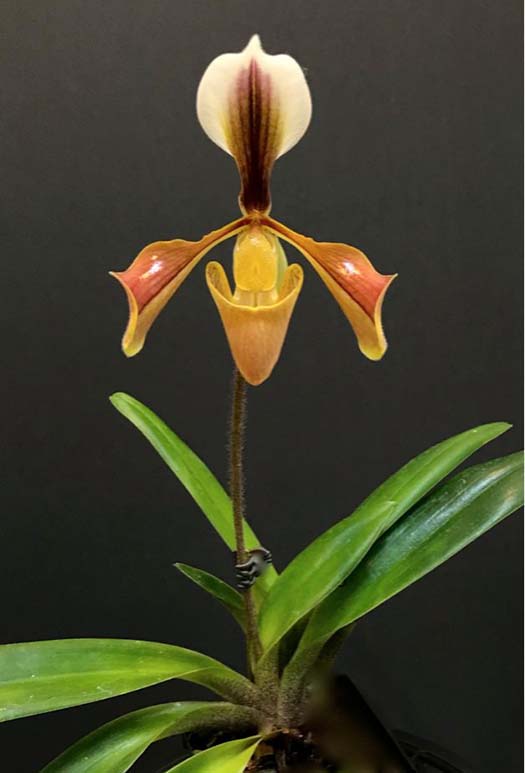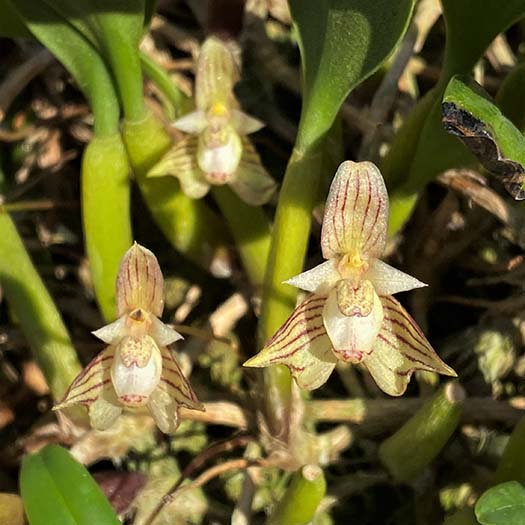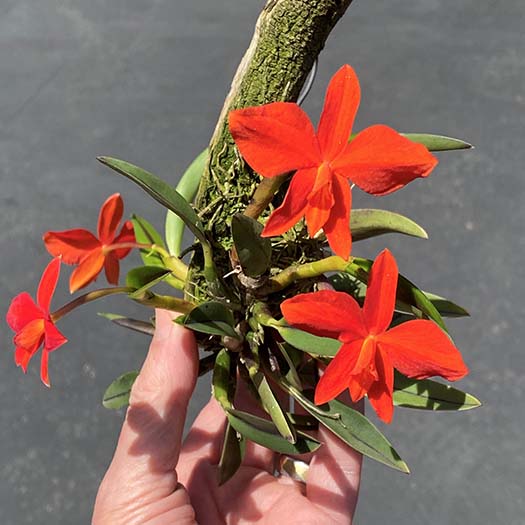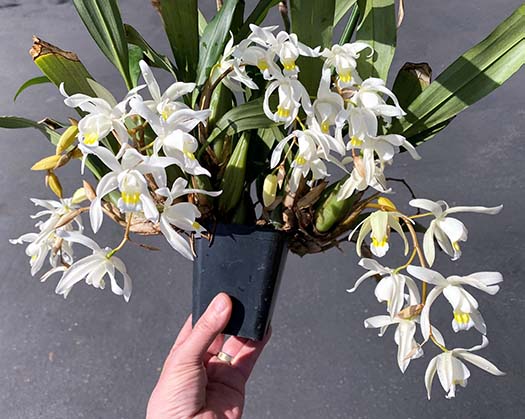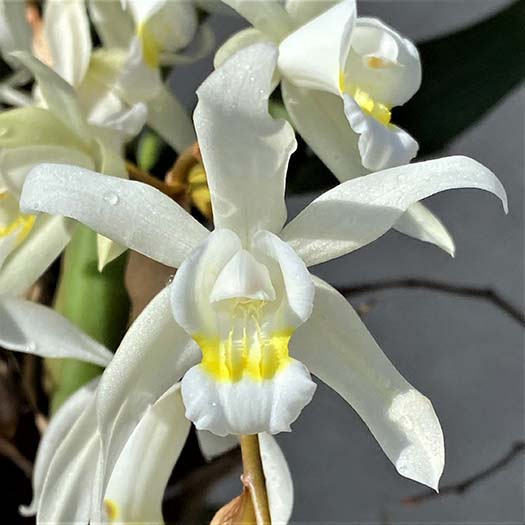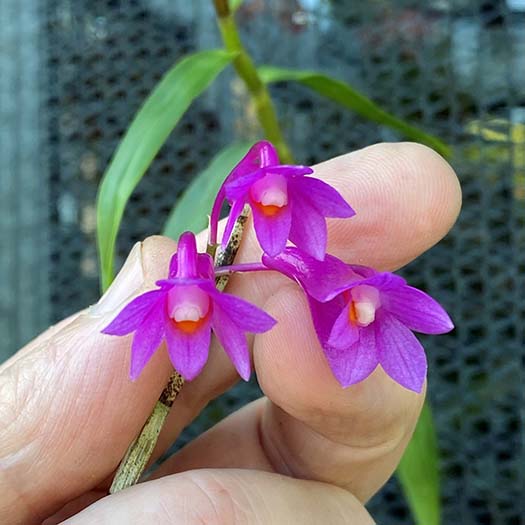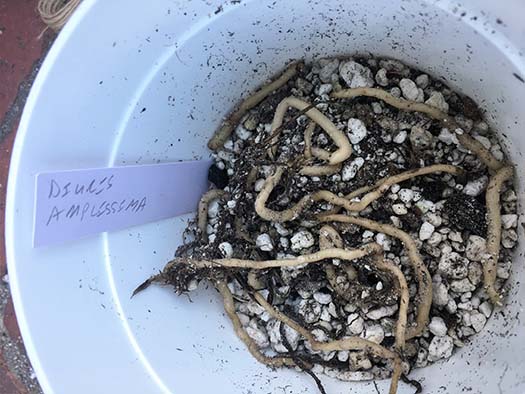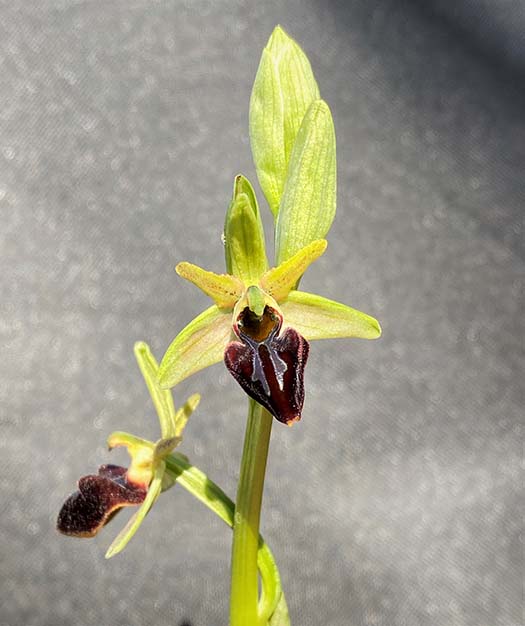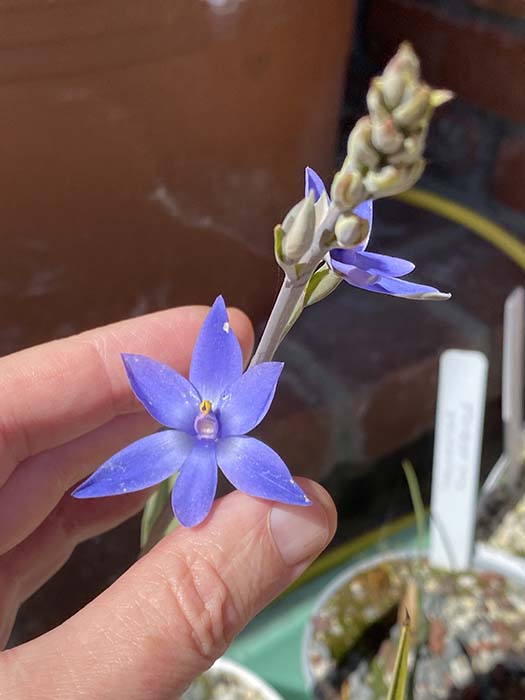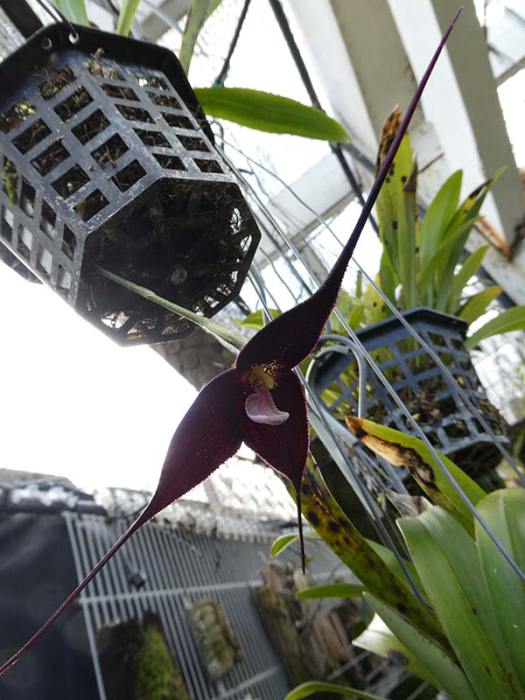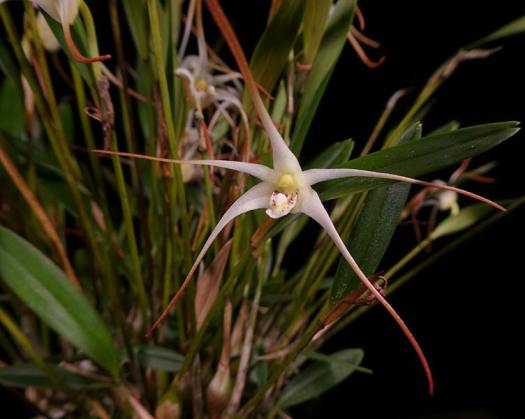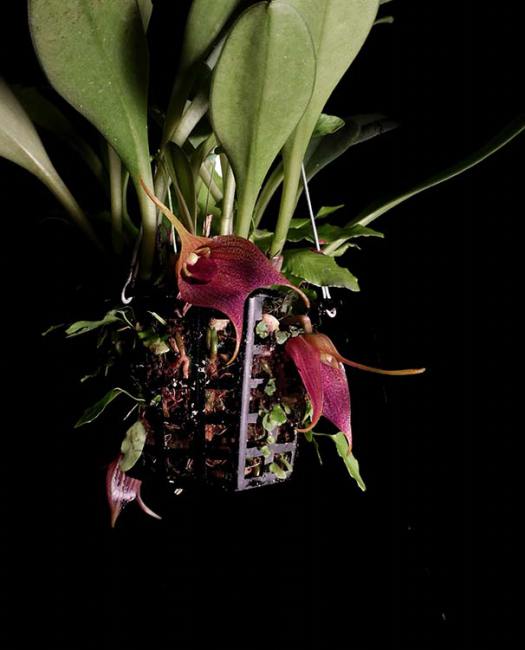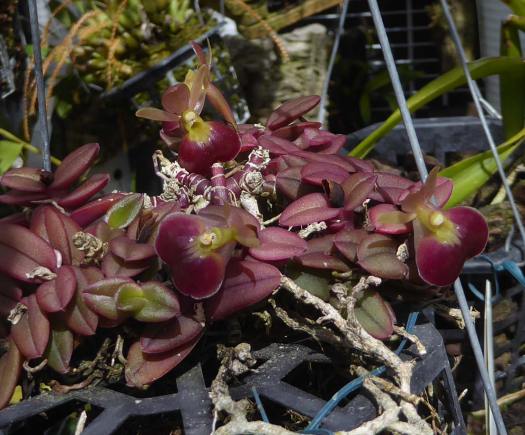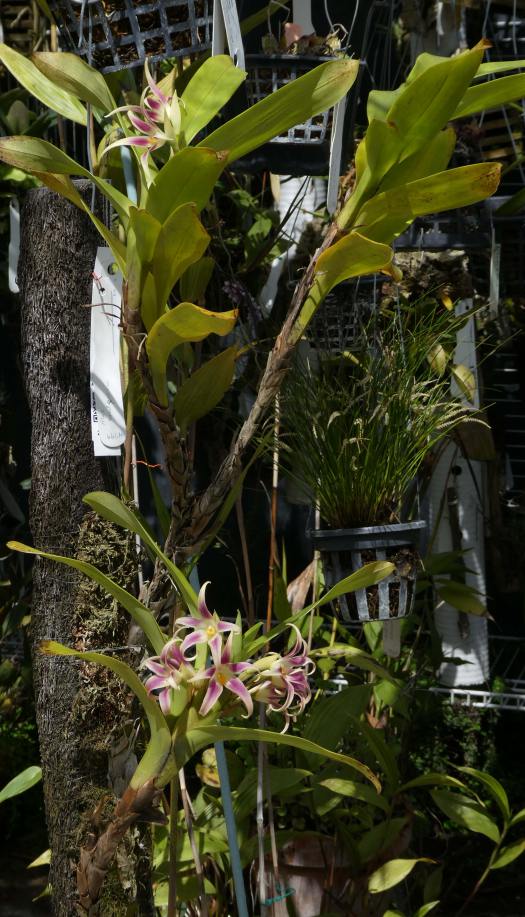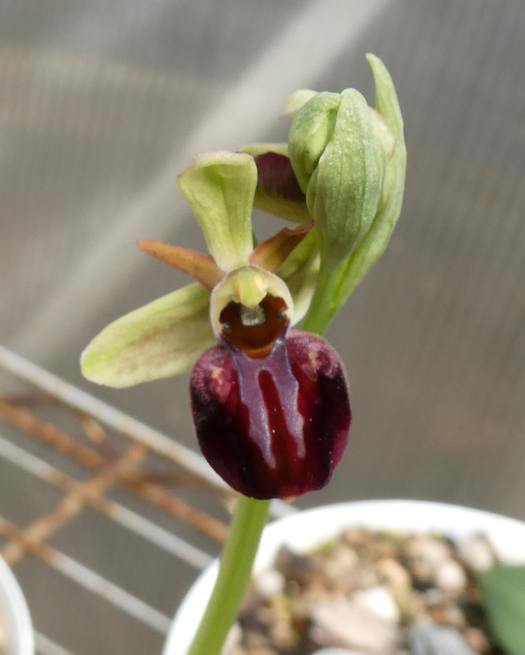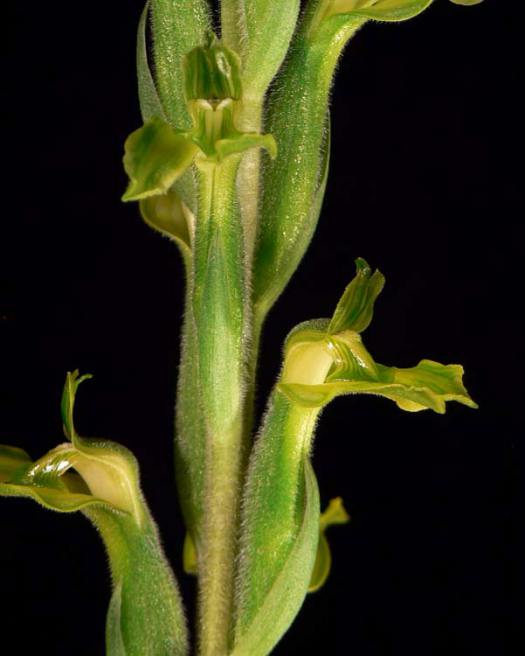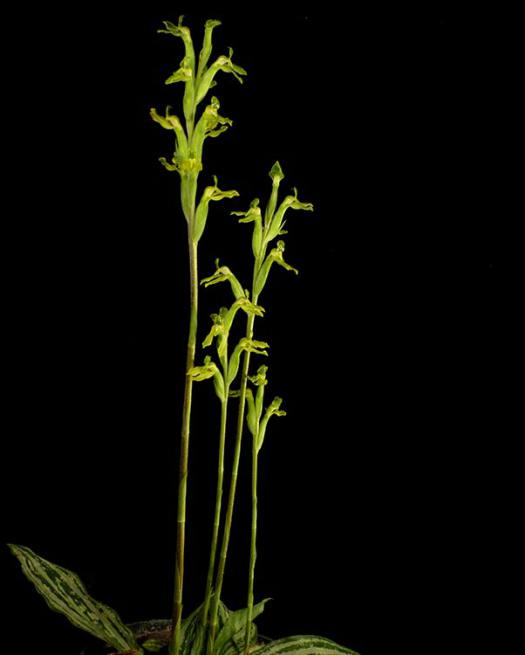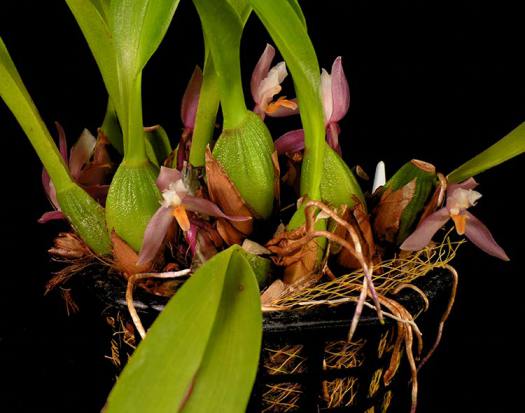April 2021
From Jan Anderson:Greenhouse-grown |
|
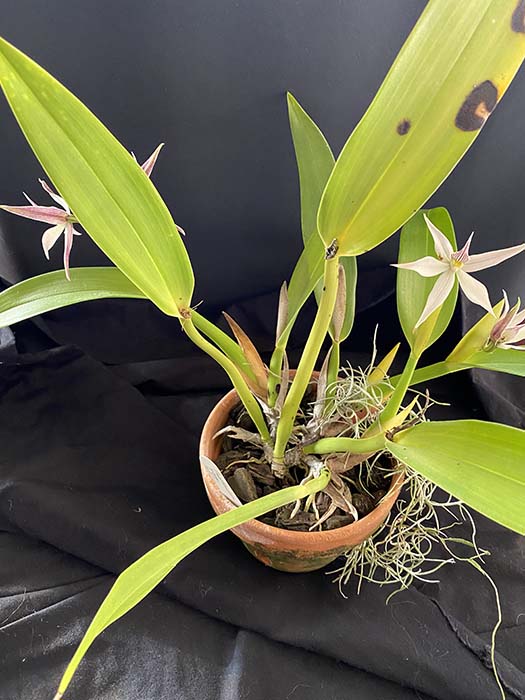 |
 |
Prosthechea sima 'Lil' |
|
 |
|
Maxillaria houtteana |
|
 |
 |
Epidendrum hugomedinae |
|
From Jan Hennessey: |
|
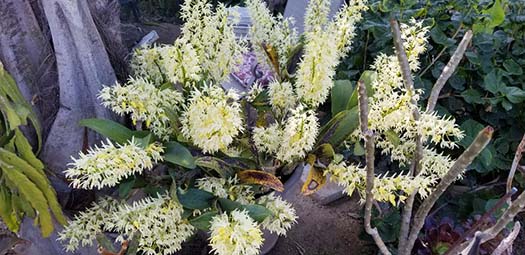
Dendrobium speciosumBeen in my yard for 20 yrs or more and shared many times. Native to Australia and New So Wales. Prefers winter rest and this is my best bloom. Very fragrant. |
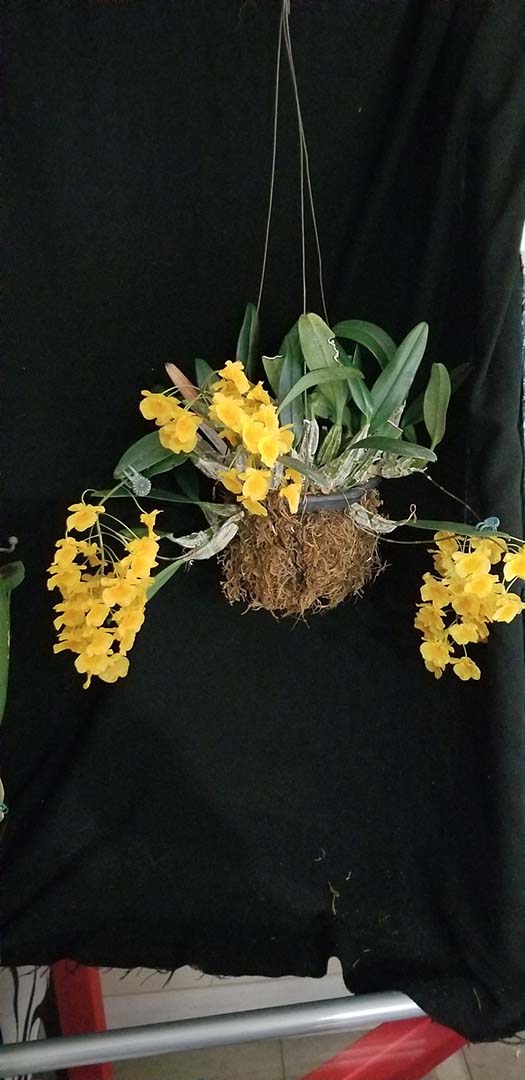
Dendrobium lindleyiDoing great this year, scented and requires a winter rest. |
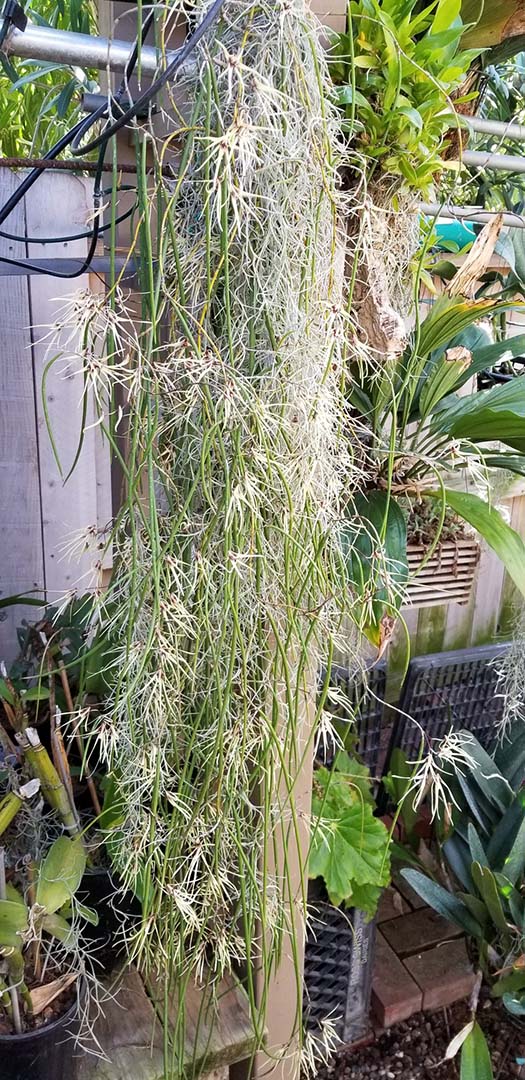 |
|
Dendrobium teretifolium var. fairfaxiiWants high light and plenty of water, mine is at the outer edge of the shade house year round. She blooms at the beginning of spring but last year it was April. Prefers winter rest, however I've never paid much attention to that. Got her in Santa Barbara a few years ago. |
|
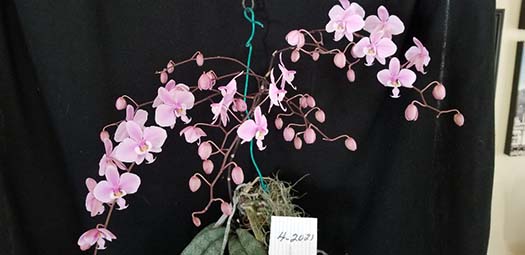
Phalaenopsis schillerianaIn the greenhouse for about 3 years now, best bloom yet. It was a small bare root. Love the dark green and silver leaves and rose scent. Found on the islands of the Philippines in hot shady, humid areas. {not by me} |
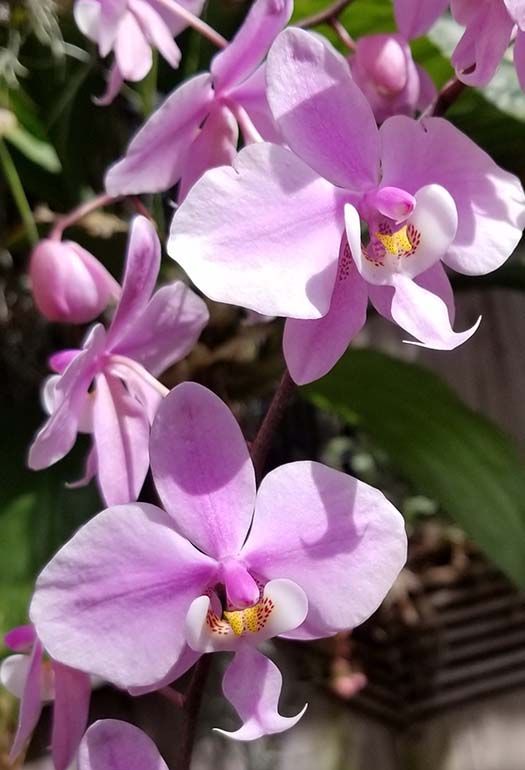 |
From Lynn Wiand:All orchids grown outdoors, coastal southern California |
|
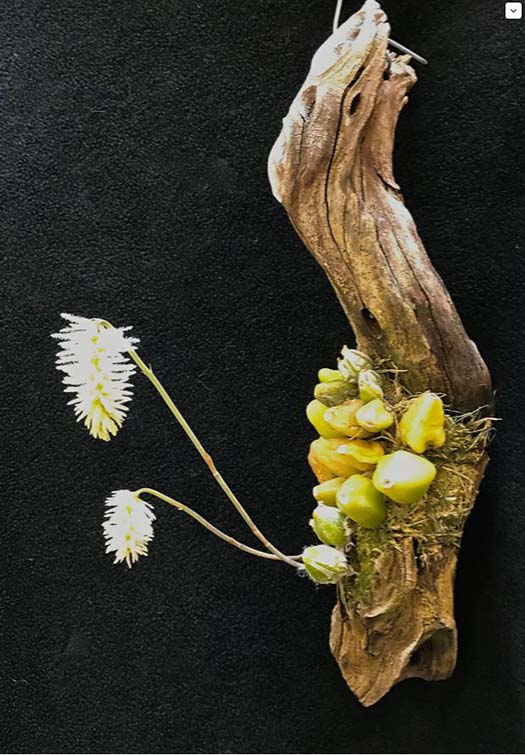
Bulbophyllum comosumFrom Burma. 2 inch plant mounted on wood. |
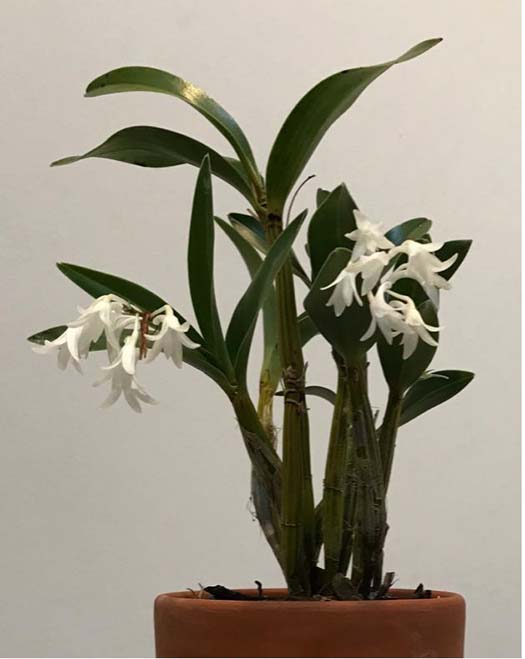
Dendrobium mooreiFrom Australia. In a 3 inch pot. |
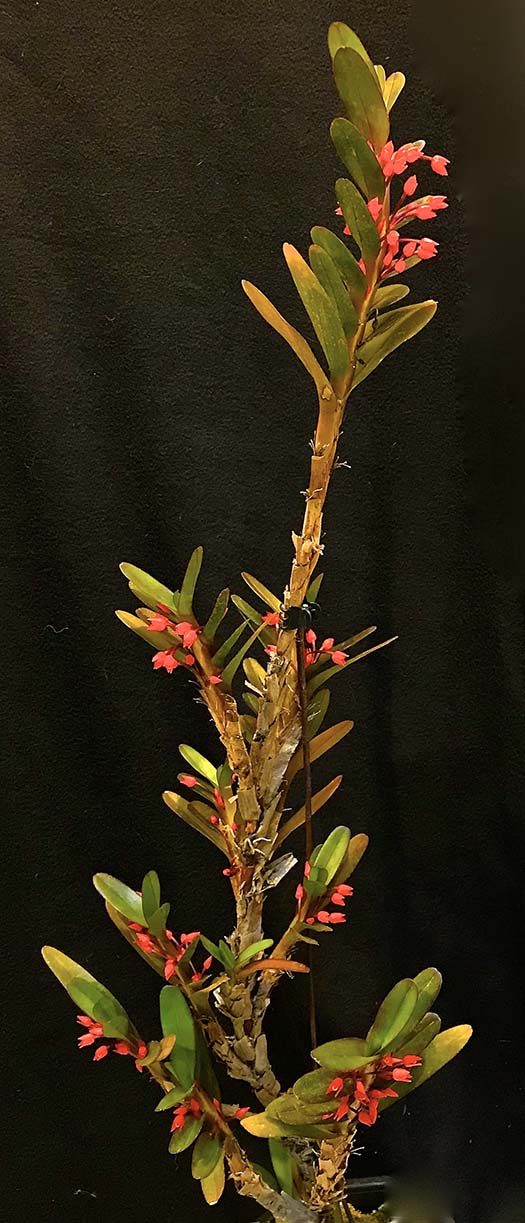
Maxillaria rolfeiFrom Colombia. In a 4 inch moss basket. |
|
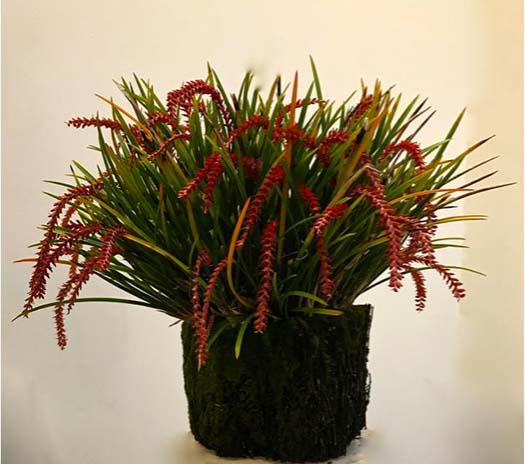 |
Dendrochilum wenzeliiFrom the Philippines. In moss in a hapu'u bowl. |
From Scott McGregor:All orchids grown outdoors, coastal southern California |
|
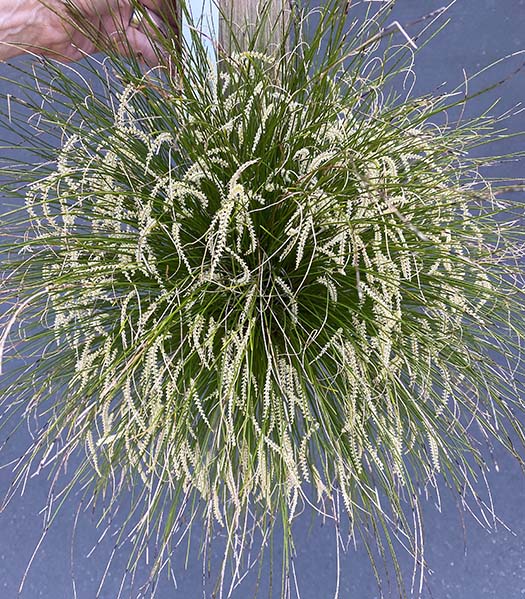
Dendrochilum tenelumTiny flowers, but there sure are a lot of them! How’d you like to be the new AOS judge who gets assigned to count ‘em? Must be 3000+ flowers! An easy outdoor grower, slightly fragrant. |
|
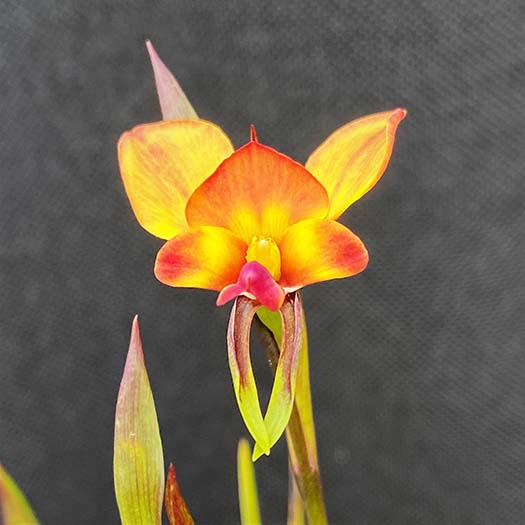 Diuris amplissimaDiuris amplissima is a Southwest Australian terrestrial (Mediterranean climate), and one of my two favorite “donkey ear” Diuris species (the other is D. magnifica). Here are the first two flowers opening on several spikes. The last pic shows the tubers in the pot at the end of the season that sprouted in October for this Spring’s bloom—they always migrate to the bottom of the pot, probably in search of the last of the season’s water. I grow them outside in full sun from December to March and they are dormant/dry in the summer. |
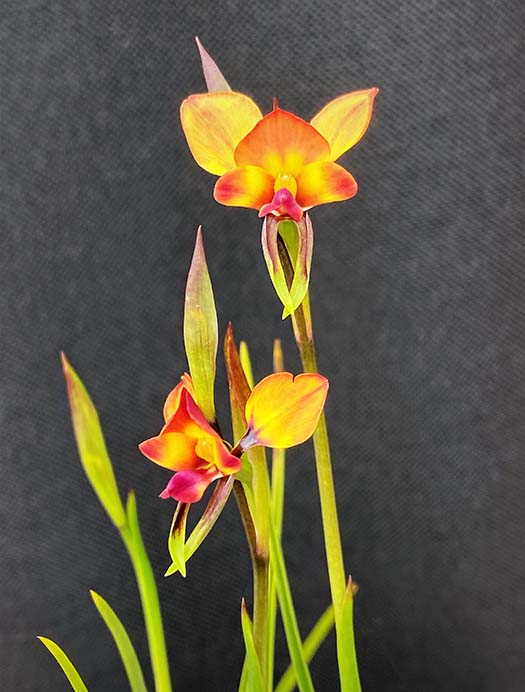 |
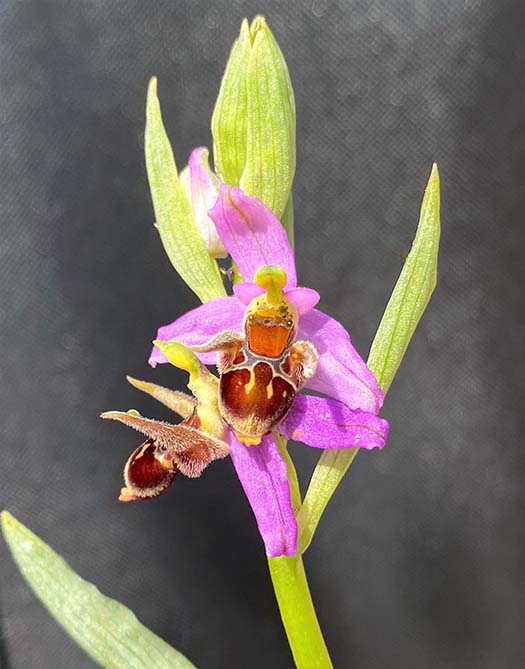
Ophrys cerastesSpots, bright colors, hairy—what more could a male bee want? I grow Ophrys cerastes outside, full sun in the winter and summer dry/dormant. Here’s a link to a pic of its pollinator, Eucera longicornus: https://www.flickr.com/photos/nico_bees_wasps/5810854825 |
|
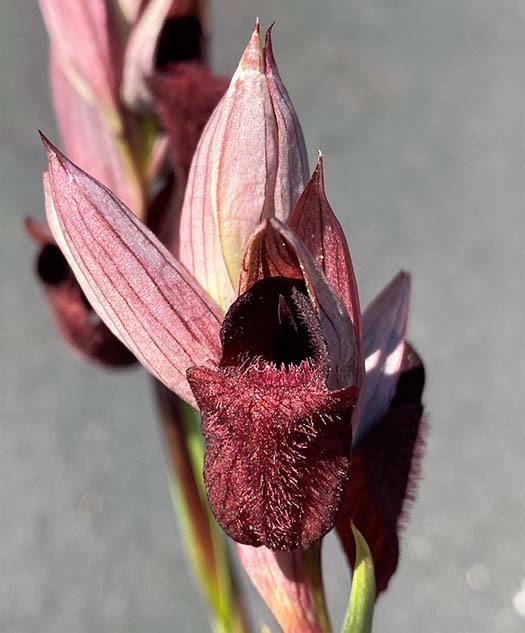
Serapias cordigeraA pot of S. cordigera in bloom. This is my favorite Serapias with deep color and a distinctive hairy lip. |
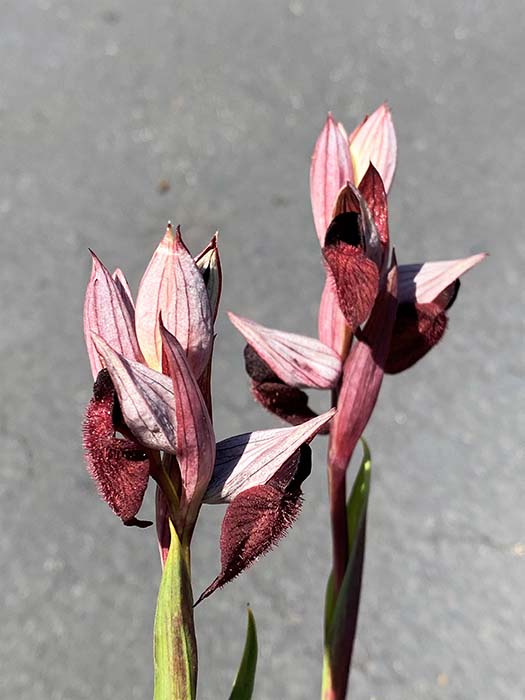 |
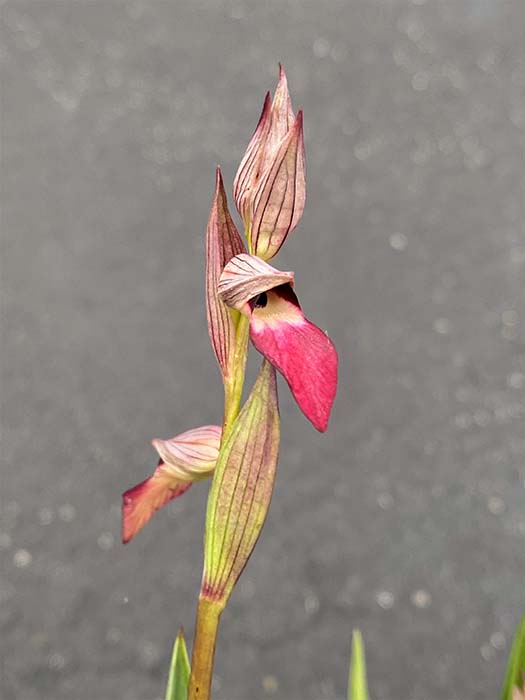 |
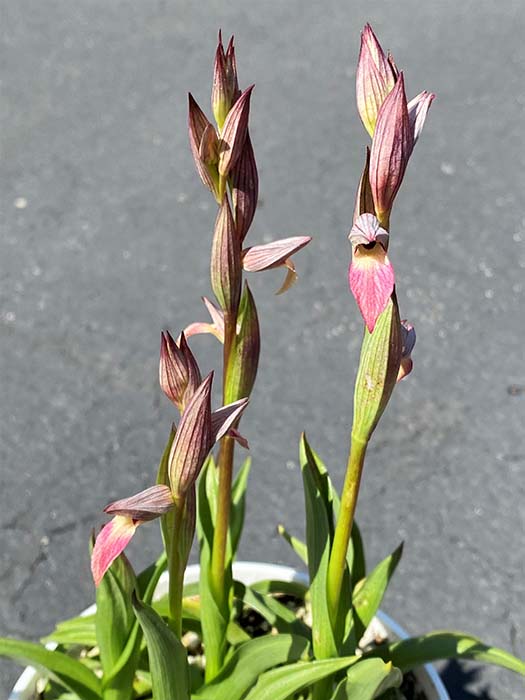 |
Serapias linguaA pot full of this easy and variable European terrestrial just beginning to flower. |
|
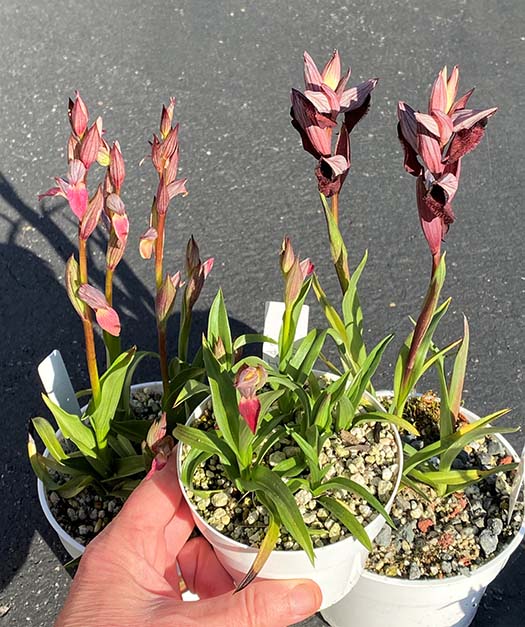
Serapias Family PhotoA few pots of Serapias lingua and cordigera (on right), showing color variations. These are the easiest of the European terrestrials and propagate well. |
|
From Roberta Fox:
|
|
Outside in the Back Yard: |
|
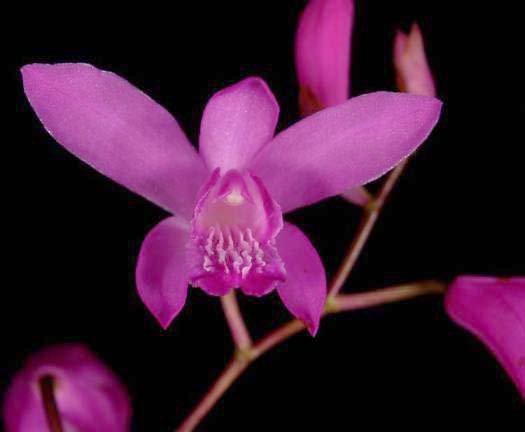 Bletilla striataThe Asian "ground orchid". This is the typical color form. I have found that it grows better in the ground (even my awful clay soil) than in a pot. It dies back in winter, to emerge anew in the spring. |
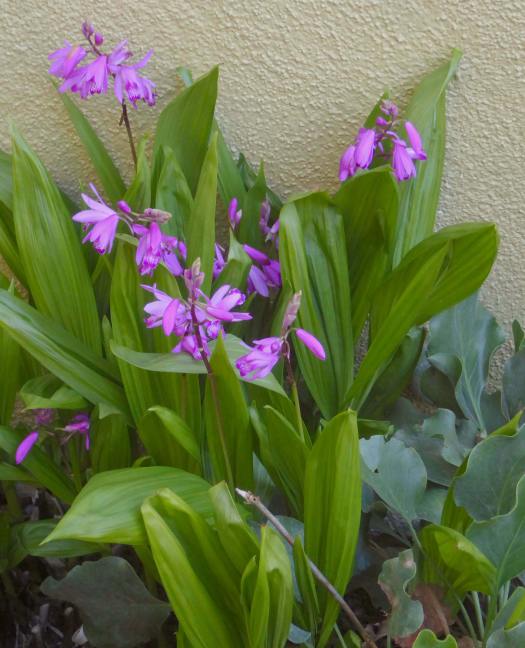 |
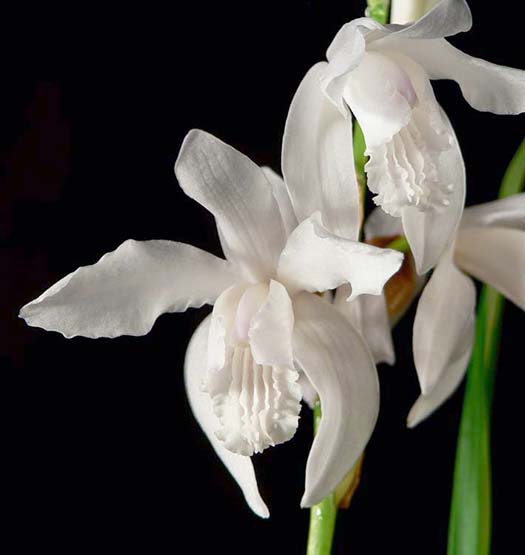 Bletilla striataSome other color forms. The alba above, and a lovely coerulea (a new acquisition) on the right. |
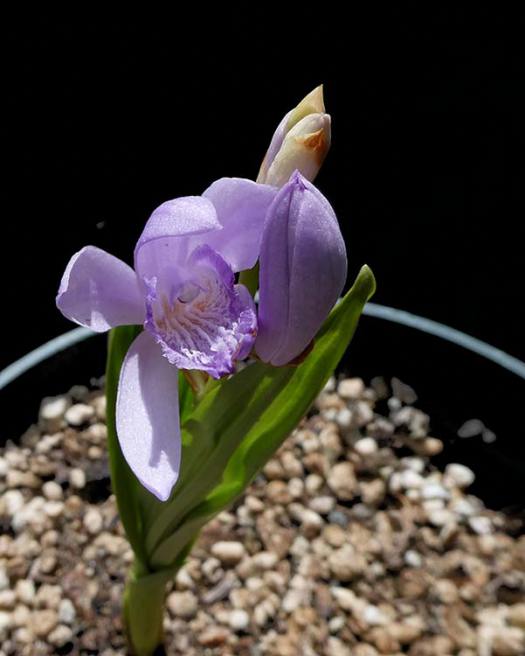 |
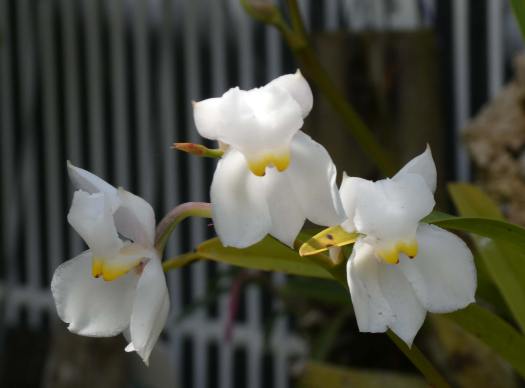
Osmoglossum pulchellumThis little Oncidium relative is extremely fragrant. It is late this year - it usually blooms in January, this year it didn't open until March and still has two more spikes to open. Flowers are quite long-lasting. |
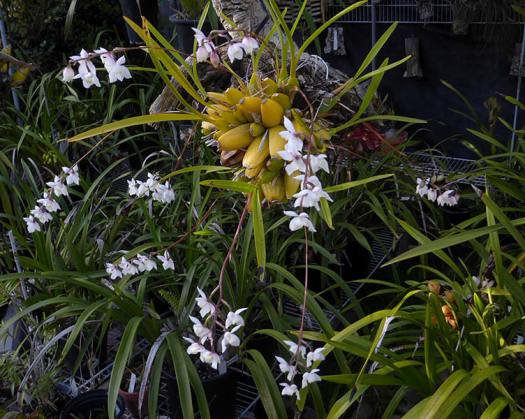 |
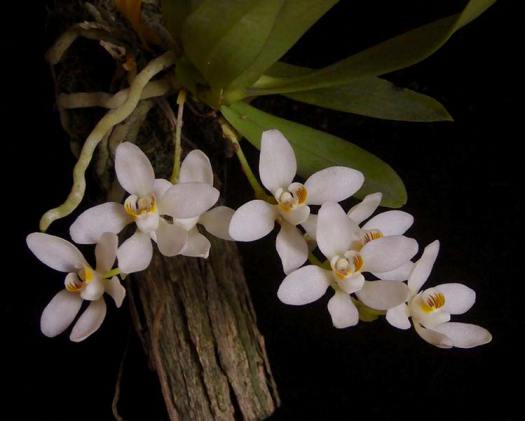 Sarcochilus falcatusCrystalline white flowers from this Australian native. It grows best mounted. |
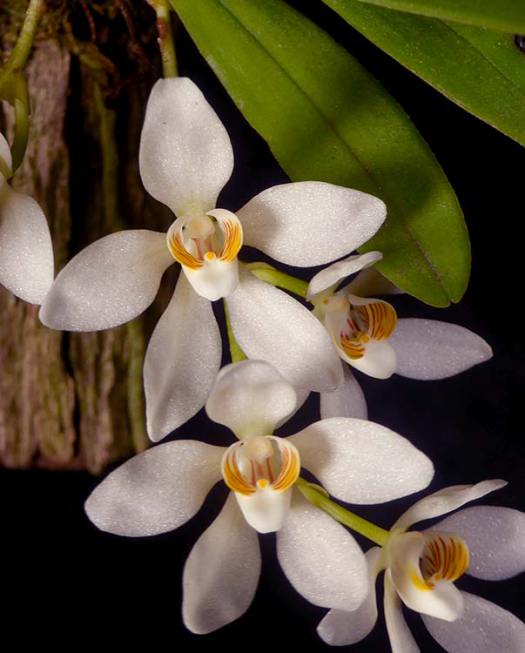 |
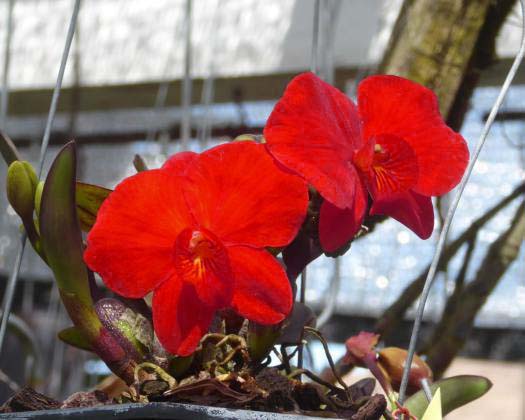 Cattleya (Sophronitis) coccinea 4nThe color is hard to capture in a photo, but this is close. These flowers say "notice me" from clear across the yard. When the flowers open, they're about 1.5 inches, but after a week or so they're 2 inches or more. They are also quite long lasting. Also, they don't all open at once, so the first ones are starting to go, but there's another batch opening to prolong the show. |
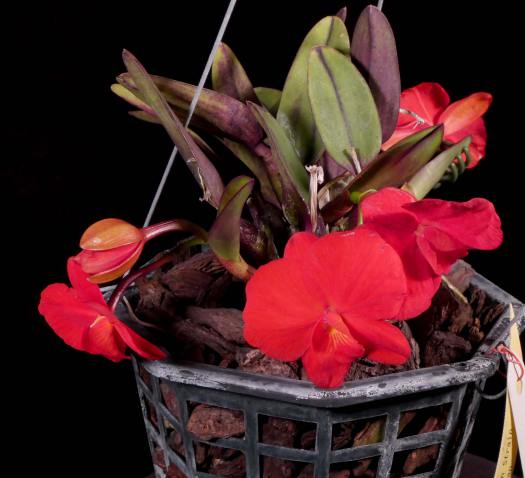 |
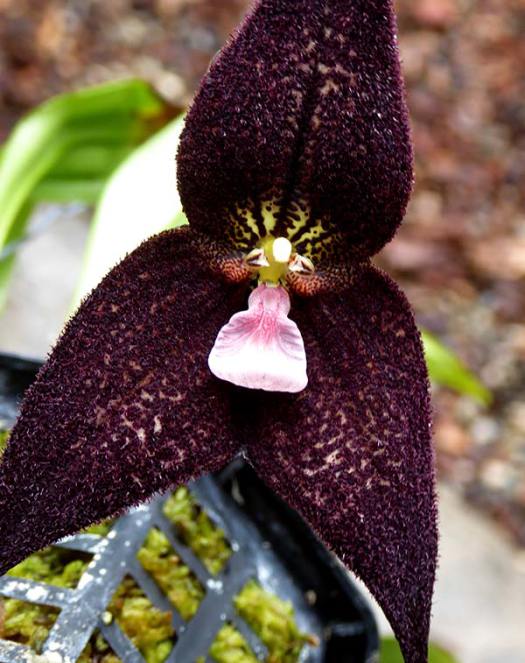 |
|
Dracula roezliiThis plant produces several flowers sequentially on a spike, and blooms several times a year. The photo on the left is what greets me when I go outside with coffee in hand - the flower is at its best in the cool of the morning. |
|
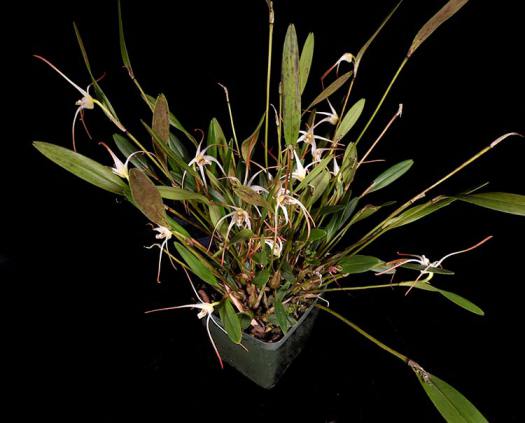 |
|
Diplocaulobium aratriferumThis one put on a good show during this month. When buds appear, it's important to pay attention... when the flowers do open, they last less than a day. They have a light fragrance of watermellon. |
|
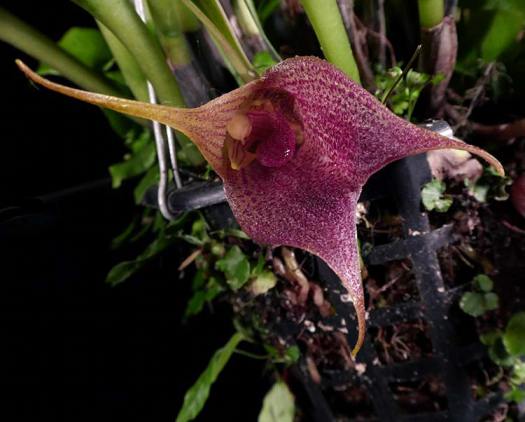 Masdevallia angulataFlowers have heavy substance and are about 2 inches across including the caudae. |
|
Dendrochilum pulcherrimumA miniature Dendrochilum with a lot of flower power in a 4 inch basket. |
|
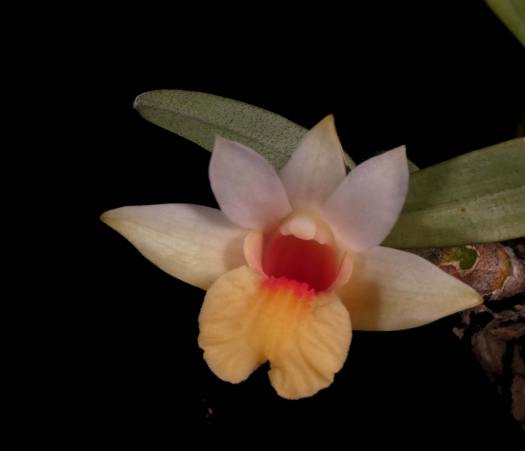
Dendrobium bellatulumFlower is about an inch, the plant not much bigger. It is semi-deciduous. I don't particularly dry it out in winter, but being mounted without sphagnum, it dries very quickly. Getting wet does not seem to inhibit blooming. |
|
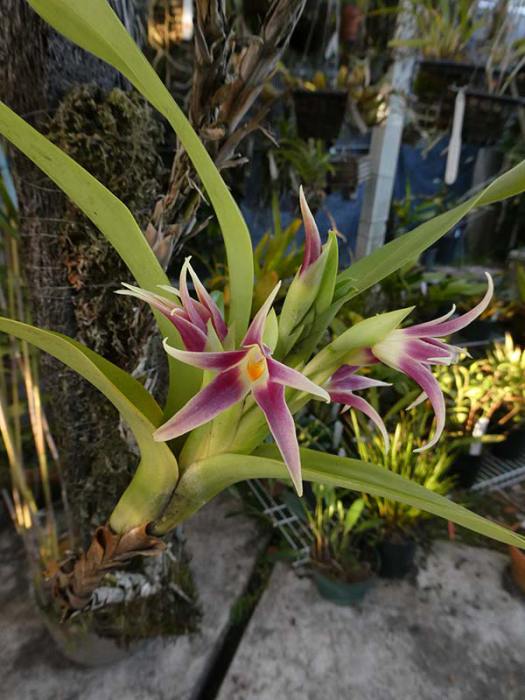 Maxillaria bradyorumThis one is NOT a miniature. Flowers have heavy, waxy substance. It produces new grows slowly, but also extends the older growths. There don't seem to be a lot of "free" roots - they are in the crevices of the hapu'u mount but don't extend beyond it. However, under those brown bracts at the base of the leaves, there is a root system that goes to the base of the plant. It is very important to not remove or disturb them. |
|
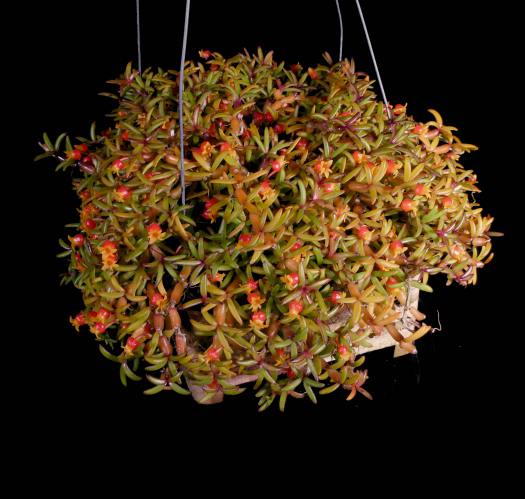
Mediocalcar decoratumHere's another plant that bloomed quite late this year. It usually blooms for me in January, I was beginning to think that it was going to skip this year (I got one little flower in January, then nothing for a couple of months) |
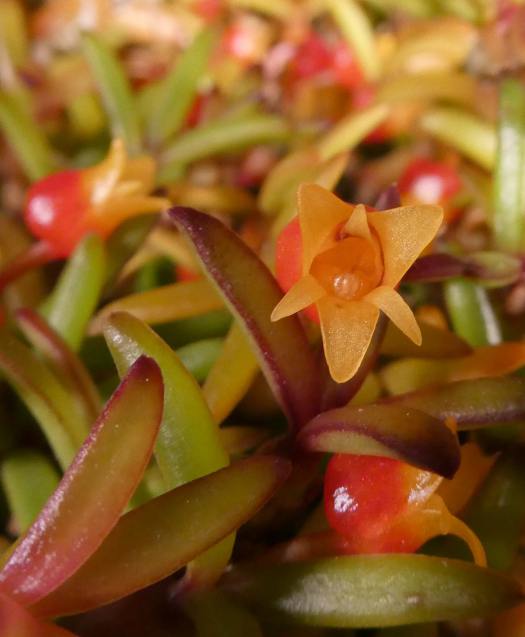 |
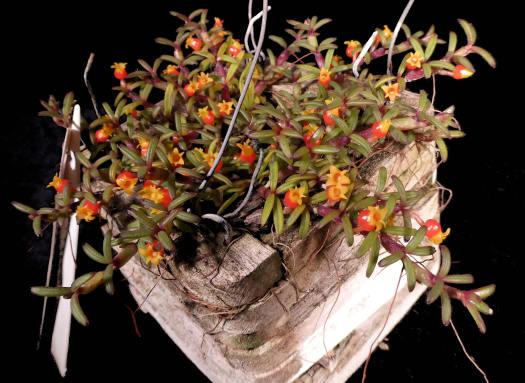 Mediocalcar pygmaeumThis is the "mini" version - the leaves and flowers are 1/2 to 2/3 the size of their Med. decoratum equivalents but otherwise look identical. |
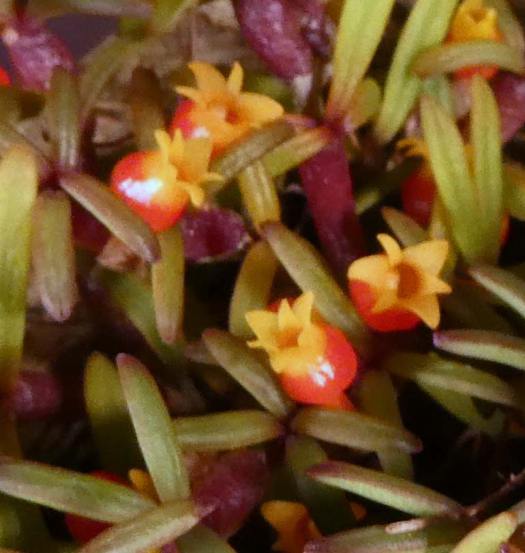 |
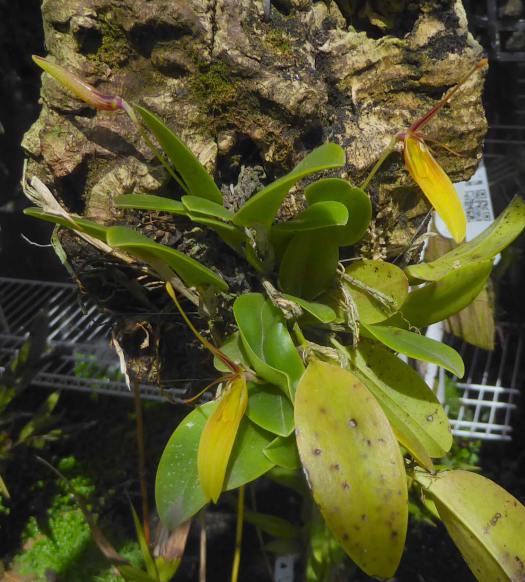 Restrepia jesupianaI give Andy Phillips the credit for my acquisition of this one. I was browsing the member sales table at the San Francisco Orchid Show a few years ago, he wandered over to look it over as well, spotted this (no flowers, no picture) and told me "You need this one." I agree... it's a pretty one! |
|
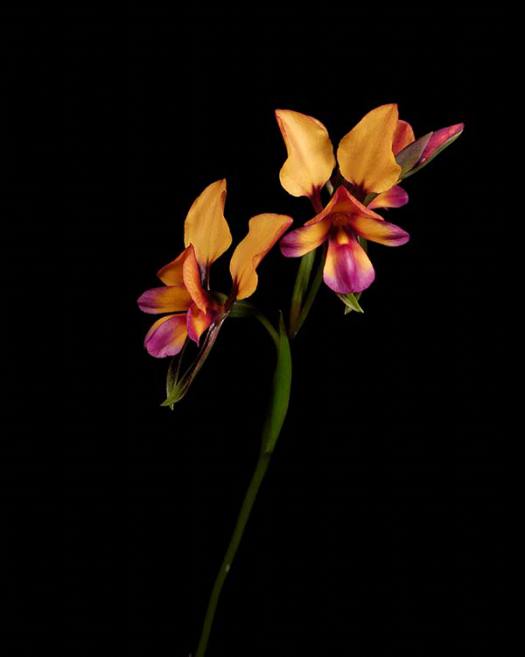
Diuris revisitedDiuris magnifica (above) and Diuris orientis (right) wre just getting started last month when I showed them to you. Here are some more photos, as they opened further. |
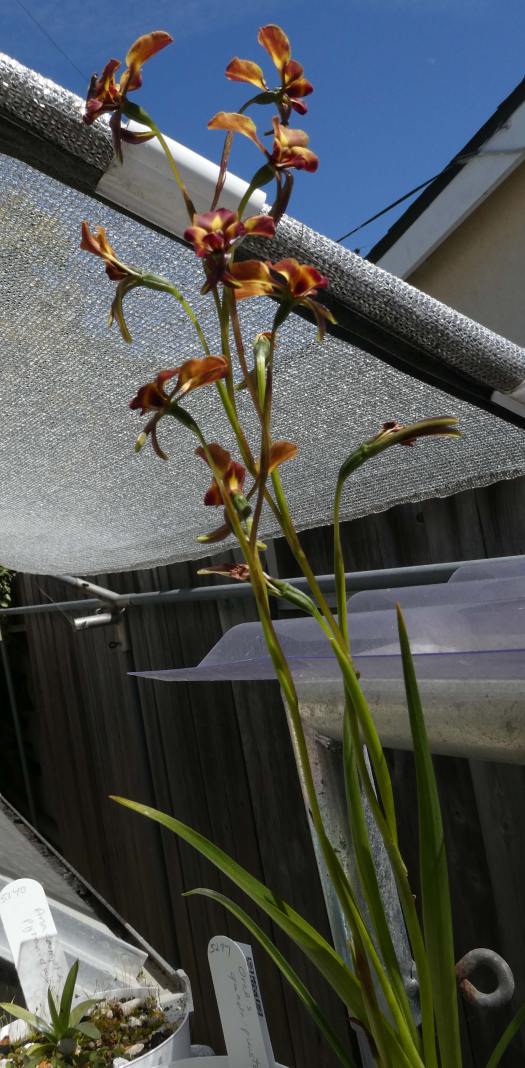 |
Ophrys luteaThis one is particularly vigorous. The brilliant yellow is distinctive. |
|
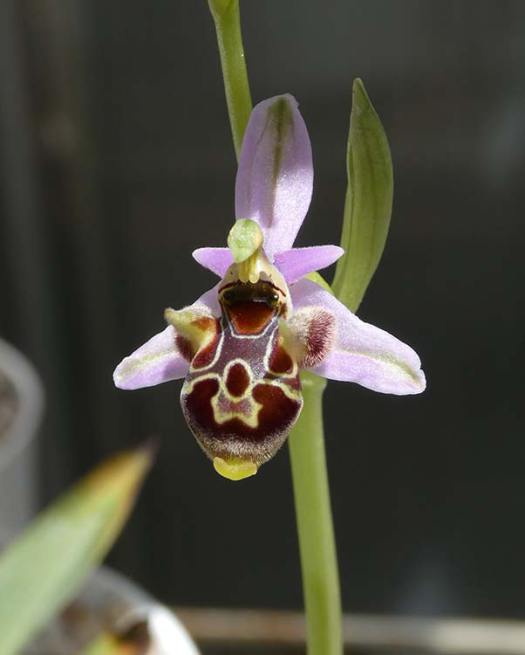 |
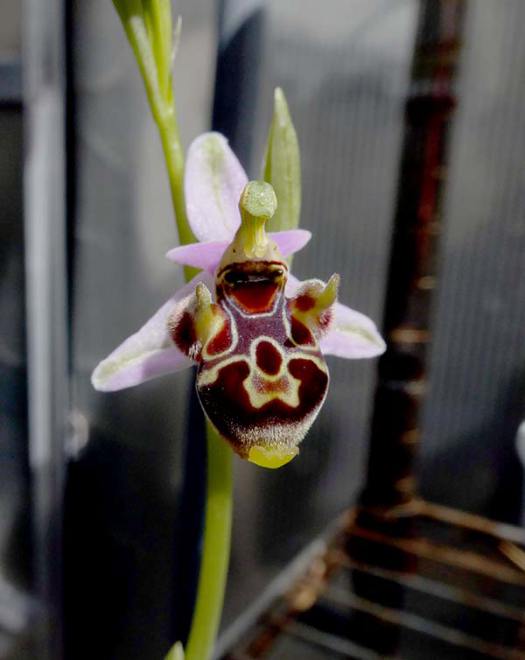 |
Ophrys scolopax (probably)I bought this one as Ophrys regis-ferdinandii (shown by Scott last month). When it bloomed it was clear that it wasn't (I'll try again when I get the opportunity) but still a beautiful flower. The ID is my best guess... Ophrys scolopax is a representative of a group of related species. |
|
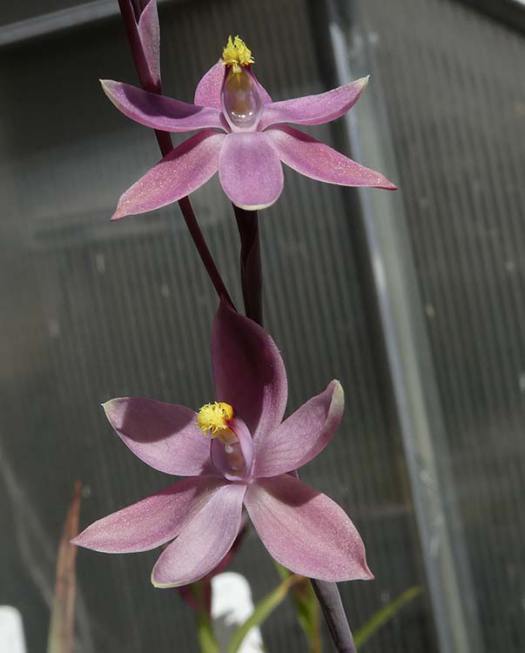 |
Thelymitra x-macmillanii x glaucophyllaMy first Thely of the season. A primary hybrid between a red and a blue Thelymitra, to me the color is not an improvement, but it is very vigorous - hybrid vigor maybe. Like all Thelymitras, the flowers only open on bright, sunny days. They close up at night, and open again when the sun hits them. |
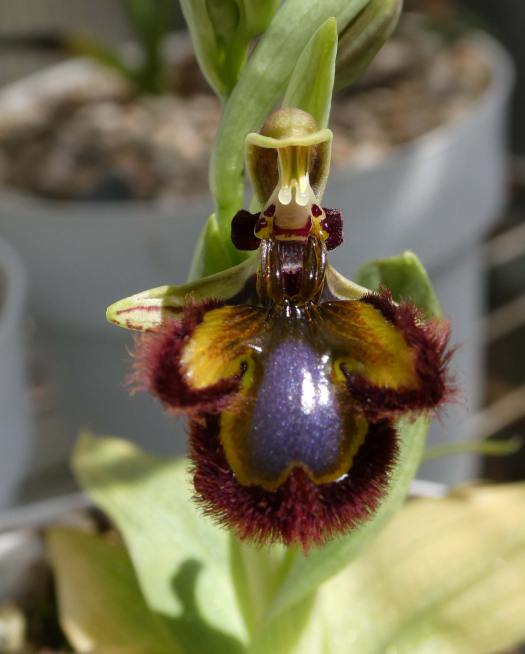 |
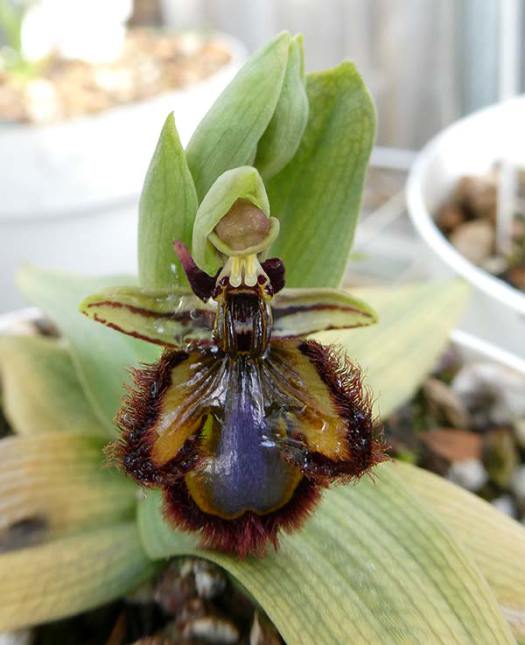 |
Ophrys speculumThis one is my favorite... The contrast between the iridescent metallic-lookng "shield" and the fuzzy "wings" and "body" makes this the perfect little bug. |
|
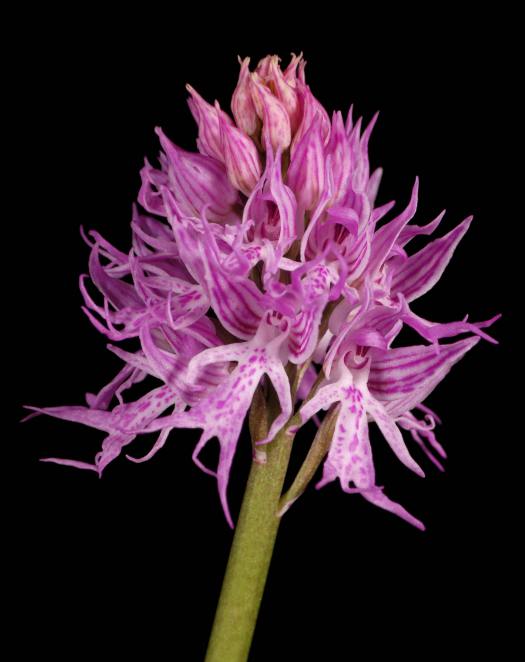
Orchis italicaOne of the "little man" orchids. This cultivar has spotted leaves - there are others without the spots. As the flowers open, the leaves are already showing signs of dormancy. Once the flowers fade, this, and the other Mediterranean-type terrestrials will be place where they don't get watered, and will be ignored until next fall. |
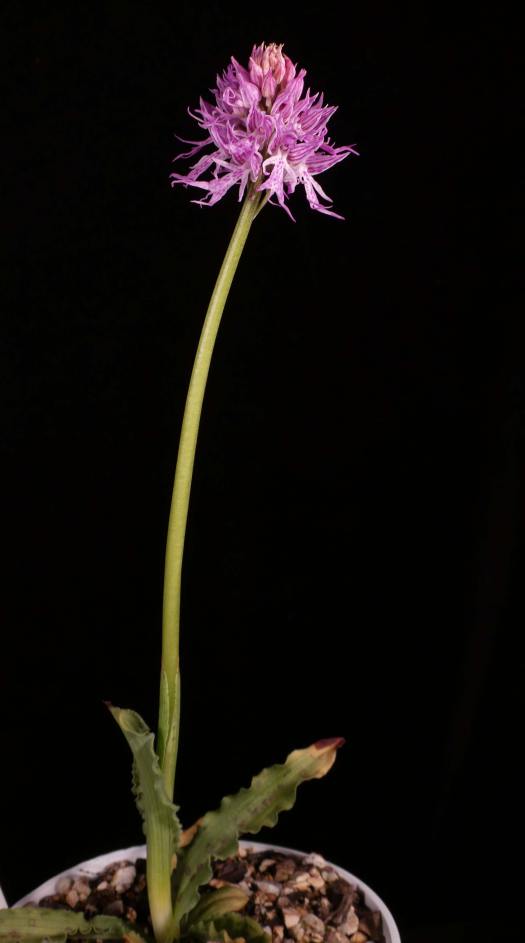 |
In the greenhouse... |
|
Sarcoglottis sceptrodesLooking a bit like a dragon or alligator. This terrestrial from Mexico and Central America can be grown as a house plant - it doesn't need a lot of light, and the leaves are attractive even when it is not in bloom. |
|
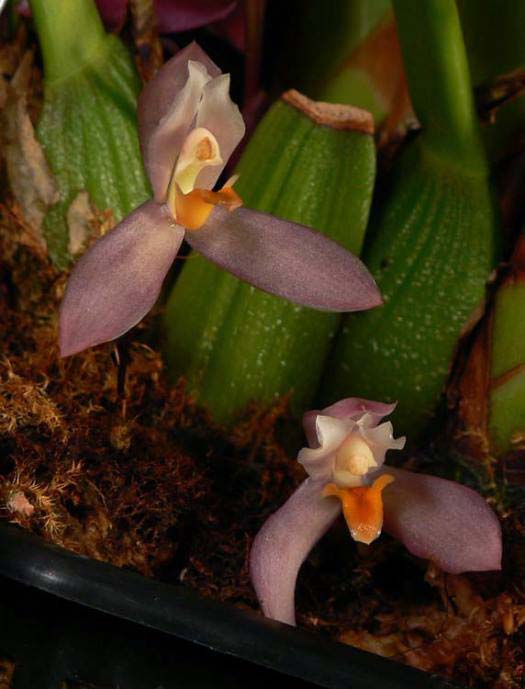 |
|
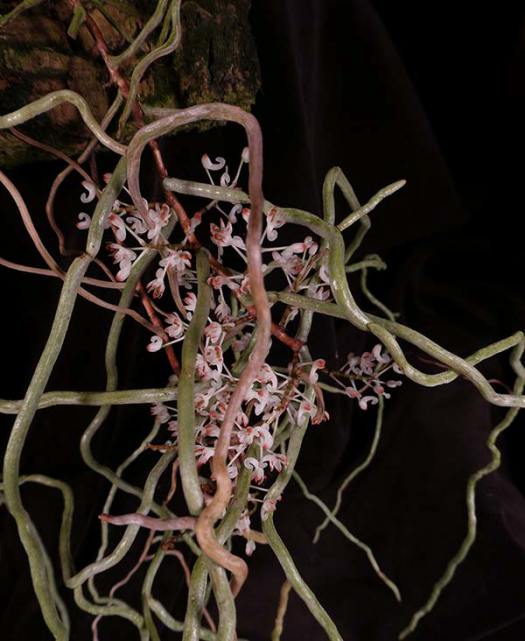 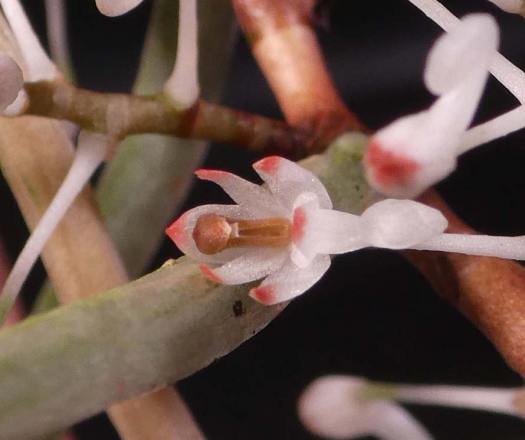 |
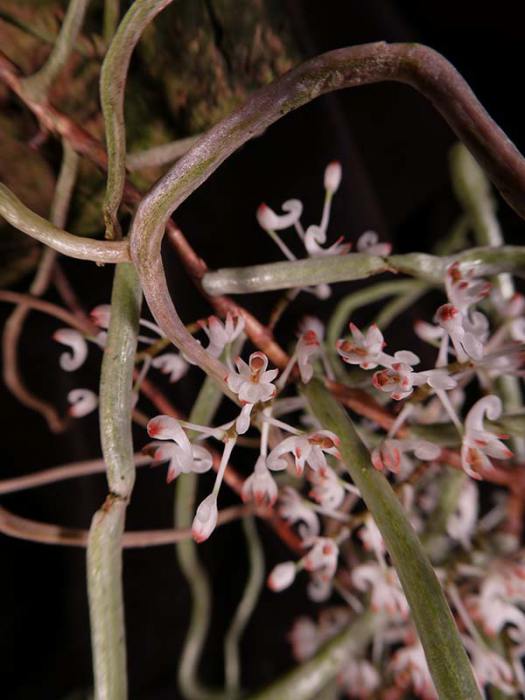
Microcoelia aphyllaThis leafless orchid is native to a wide area of central and eastern Africa, at elevations from sea level to about 300 meters. In the greenhouse it can stay both warm and wet. The flowers are only about 1/4 inch, but there are lots of them. |
